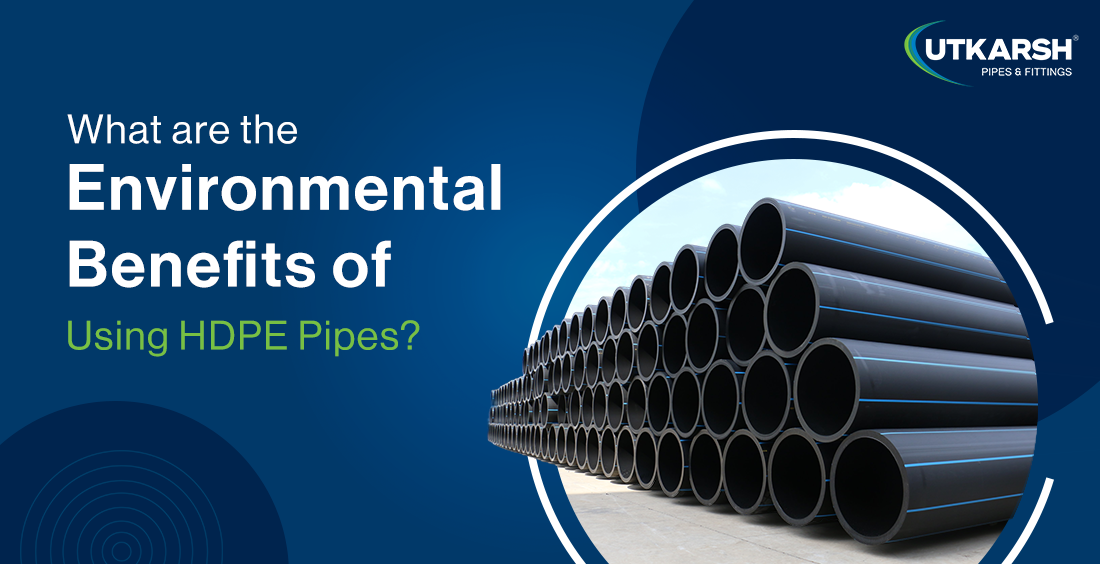What are the environmental benefits of using HDPE pipes?

It’s important to know the sustainability qualities of materials before choosing them for infrastructure. Many traditional materials require high energy for production and cause significant environmental impact. HDPE pipes offer a more sustainable alternative due to their durability, recyclability, and lower carbon footprint. As one of the leading HDPE pipes & fittings manufacturers, we share some of the environmental benefits of using these pipes:
Recyclability
HDPE pipes can be recycled. Manufacturers can process used pipes to create new ones or repurpose the material for other products. This method significantly reduces landfill waste and prevents unnecessary accumulation of discarded plastic. By giving old HDPE pipes a second life, industries conserve valuable raw materials that would otherwise require extraction and processing.
Unlike single-use plastics that contribute to pollution, HDPE pipes remain valuable after their initial service life. The ability to recycle these pipes reduces dependency on virgin materials and decreases demand for energy-intensive production processes. This shift lessens the strain on natural resources.
In addition to resource conservation, HDPE recycling lowers greenhouse gas emissions. Producing new plastic from raw materials requires more energy than reprocessing existing plastic.
Durability and Longevity
HDPE pipes offer exceptional longevity, lasting between 50 and 100 years in many applications. Their durability makes them a cost-effective solution for infrastructure projects and reduces the need for frequent replacements. Unlike traditional materials that degrade over time, HDPE pipes maintain their structural integrity under various environmental conditions. This reliability ensures long-term functionality, even in challenging environments.
Corrosion resistance plays a key role in extending the lifespan of HDPE pipes. This feature eliminates the need for protective coatings or treatments, which reduces maintenance costs and resource consumption. HDPE pipes also resist cracks and fractures, which ensures a stable and secure piping system.
They can withstand ground movement, which makes them ideal for areas prone to earthquakes or soil shifts. This adaptability reduces the risk of pipe failure and prevents costly repairs and environmental damage. Traditional rigid materials, such as concrete, often fail under similar conditions and develop cracks or breakages.
Using HDPE pipes lowers the demand for new raw materials. Fewer replacements reduce extraction and processing of resources, which helps to conserve the environment.
Prevention of Pollution
Their strong structure keeps water, sewage, or chemicals contained within the pipeline system. This characteristic limits the risk of soil and water pollution, which preserves natural ecosystems. Leaks in traditional pipe materials often lead to harmful substances seeping into the environment and causing long-term damage. HDPE pipes eliminate this risk by offering a safer alternative.
Many industrial processes involve the transport of chemicals through pipelines. HDPE pipes can withstand a wide range of chemicals without breaking down. This quality makes them ideal for industries that require secure containment of hazardous substances.
Broken sewer pipes release untreated waste into surrounding areas, which leads to serious health hazards. The durability of HDPE ensures that wastewater stays enclosed and reduces the risk of pollution.
By stopping leaks and breakages, HDPE pipes help maintain clean water supplies and protect ecosystems.
Lower Installation Impact
HDPE pipes require less excavation. This means they need smaller trenches, meaning less soil needs to be dug up and moved. This has many positive effects on the environment:
Decreased habitat destruction: Less soil disturbance means less disruption to the homes of insects and worms. This helps maintain the health and biodiversity of the soil ecosystem.
Reduced erosion risk: Exposed soil is vulnerable to erosion from wind and rain. Smaller trenches minimise this risk. They prevent topsoil loss and protect waterways from sedimentation.
Faster project completion: Less excavation leads to quicker installation times. This reduces the overall impact on the surrounding environment.
Water Conservation
HDPE underground water pipes have a leak-tight design that prevents water loss: This is a major advantage over traditional pipe materials, which are prone to developing cracks and leaks over time.
Reduced water wastage: Leaky pipes can waste significant amounts of water and lead to shortages and increased costs. HDPE pipes minimize this wastage - they ensure that water resources are delivered efficiently to communities.
Protection of water sources: Water loss from leaky pipes not only wastes water but can also contaminate surrounding soil and groundwater sources. HDPE pipes help protect these resources by preventing leaks and ensuring the integrity of the water distribution system.
At Utkarsh Pipes, we remain committed to providing environmentally friendly products. Our HDPE pipes provide a durable and efficient solution for modern infrastructure. With a lifespan of 50 to 100 years, they resist corrosion, abrasion, and chemical damage. Experience seamless fluid flow with Utkarsh Pipes & Fittings, engineered for efficiency and endurance.
With a consistently high C' value above 150, our pipes ensure effortless transportation and minimal energy loss. Built with exceptional Slow Crack Growth Resistance (SCGR), they stand strong under pressure — delivering reliability even in acidic or alkaline environments. Enjoy leak-free joints, reduced surge pressures, and a system that stays stable and long-lasting — the Utkarsh promise of strength and performance.
Their lightweight design lowers transportation costs, and longer delivery lengths reduce the requirement for fittings. High flexibility allows installation over bends without additional joints, thereby simplifying construction. The pipes resist incrustation and scale formation which ensures low pumping costs and sustained efficiency. Using non-toxic, zinc-based stabilizers ensures safe water transport.











